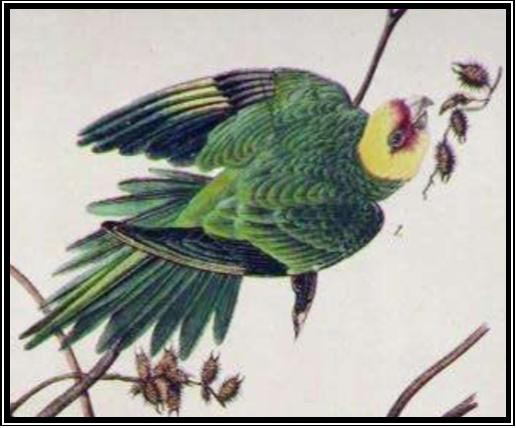
COULD THE NATURALIZED, WILD QUAKER FILL THE GAP?
The bird at your left is Conuropsis carolinensis, the Carolina Parakeet, member of the conure family and the only parrot indigenous to North America. Rare by the 1800's and extinct in the early 1900's, it once ranged over most of the United States east of the great plains. With the spread of agriculture, this beautiful bird developed a liking for the seeds of many kinds of fruit and grain crops. It was condemned as a pest and subjected to wholesale slaughter.
Cockleburs, which the Carolina Parakeet in the picture is about to eat, began to disappear as deforestation progressed. Faced to search for other foods, the Carolina Parakeet began to flock to orchards and fields, consumming crops. When one member of the flock was shot by disgruntled farmers, the others would fly around over their fallen companion instead of leaving for safety. In this manner, an entire flock could easily be destroyed.
In addition to being killed because of crop consumption, the Carolina Parakeet was killed for its colorful feathers which were usied in the millinery trade. Some were kept as pets or sold to zoos. Unsuccessful as breeders in captivity, none survive today.
Several parallels between the Carolina Parakeet and the Quaker Parakeet. Both were successful in adapting to a variety of climates. The Carolina Parakeet was, and the Quaker is, a colorful, small parrot that lived on an diet of seeds, buds, and fruits. The Quaker is kept as a cage bird, as was the Carolina Parakeet. Both have been hunted by farmers who thought their crops were threatened.
Today. the naturalized wild Quaker faces very similar challenges that the Carolina Parakeet was unable to survive. With a wider understanding of, and compassion for the Quaker Parakeet, might not the species fill the gap left by the extinction of the Carolina Parakeet?